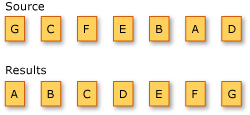Merk
Tilgang til denne siden krever autorisasjon. Du kan prøve å logge på eller endre kataloger.
Tilgang til denne siden krever autorisasjon. Du kan prøve å endre kataloger.
A sorting operation orders the elements of a sequence based on one or more attributes. The first sort criterion performs a primary sort on the elements. By specifying a second sort criterion, you can sort the elements within each primary sort group.
Important
These samples use an System.Collections.Generic.IEnumerable<T> data source. Data sources based on System.Linq.IQueryProvider use System.Linq.IQueryable<T> data sources and expression trees. Expression trees have limitations on the allowed C# syntax. Furthermore, each IQueryProvider data source, such as EF Core may impose more restrictions. Check the documentation for your data source.
The following illustration shows the results of an alphabetical sort operation on a sequence of characters:

The standard query operator methods that sort data are listed in the following section.
Methods
| Method Name | Description | C# Query Expression Syntax | More Information |
|---|---|---|---|
| OrderBy | Sorts values in ascending order. | orderby |
Enumerable.OrderBy Queryable.OrderBy |
| OrderByDescending | Sorts values in descending order. | orderby … descending |
Enumerable.OrderByDescending Queryable.OrderByDescending |
| ThenBy | Performs a secondary sort in ascending order. | orderby …, … |
Enumerable.ThenBy Queryable.ThenBy |
| ThenByDescending | Performs a secondary sort in descending order. | orderby …, … descending |
Enumerable.ThenByDescending Queryable.ThenByDescending |
| Reverse | Reverses the order of the elements in a collection. | Not applicable. | Enumerable.Reverse Queryable.Reverse |
Note
The following examples in this article use the common data sources for this area.
Each Student has a grade level, a primary department, and a series of scores. A Teacher also has a City property that identifies the campus where the teacher holds classes. A Department has a name, and a reference to a Teacher who serves as the department head.
You can find the example data set in the source repo.
public enum GradeLevel
{
FirstYear = 1,
SecondYear,
ThirdYear,
FourthYear
};
public class Student
{
public required string FirstName { get; init; }
public required string LastName { get; init; }
public required int ID { get; init; }
public required GradeLevel Year { get; init; }
public required List<int> Scores { get; init; }
public required int DepartmentID { get; init; }
}
public class Teacher
{
public required string First { get; init; }
public required string Last { get; init; }
public required int ID { get; init; }
public required string City { get; init; }
}
public class Department
{
public required string Name { get; init; }
public int ID { get; init; }
public required int TeacherID { get; init; }
}
Note
You can refer to the common data sources for this area in the Standard Query Operators Overview article.
Primary Ascending Sort
The following example demonstrates how to use the orderby clause in a LINQ query to sort the array of teachers by family name, in ascending order.
IEnumerable<string> query = from teacher in teachers
orderby teacher.Last
select teacher.Last;
foreach (string str in query)
{
Console.WriteLine(str);
}
The equivalent query written using method syntax is shown in the following code:
IEnumerable<string> query = teachers
.OrderBy(teacher => teacher.Last)
.Select(teacher => teacher.Last);
foreach (string str in query)
{
Console.WriteLine(str);
}
Primary Descending Sort
The next example demonstrates how to use the orderby descending clause in a LINQ query to sort the teachers by family name, in descending order.
IEnumerable<string> query = from teacher in teachers
orderby teacher.Last descending
select teacher.Last;
foreach (string str in query)
{
Console.WriteLine(str);
}
The equivalent query written using method syntax is shown in the following code:
IEnumerable<string> query = teachers
.OrderByDescending(teacher => teacher.Last)
.Select(teacher => teacher.Last);
foreach (string str in query)
{
Console.WriteLine(str);
}
Secondary Ascending Sort
The following example demonstrates how to use the orderby clause in a LINQ query to perform a primary and secondary sort. The teachers are sorted primarily by city and secondarily by their family name, both in ascending order.
IEnumerable<(string, string)> query = from teacher in teachers
orderby teacher.City, teacher.Last
select (teacher.Last, teacher.City);
foreach ((string last, string city) in query)
{
Console.WriteLine($"City: {city}, Last Name: {last}");
}
The equivalent query written using method syntax is shown in the following code:
IEnumerable<(string, string)> query = teachers
.OrderBy(teacher => teacher.City)
.ThenBy(teacher => teacher.Last)
.Select(teacher => (teacher.Last, teacher.City));
foreach ((string last, string city) in query)
{
Console.WriteLine($"City: {city}, Last Name: {last}");
}
Secondary Descending Sort
The next example demonstrates how to use the orderby descending clause in a LINQ query to perform a primary sort, in ascending order, and a secondary sort, in descending order. The teachers are sorted primarily by city and secondarily by their family name.
IEnumerable<(string, string)> query = from teacher in teachers
orderby teacher.City, teacher.Last descending
select (teacher.Last, teacher.City);
foreach ((string last, string city) in query)
{
Console.WriteLine($"City: {city}, Last Name: {last}");
}
The equivalent query written using method syntax is shown in the following code:
IEnumerable<(string, string)> query = teachers
.OrderBy(teacher => teacher.City)
.ThenByDescending(teacher => teacher.Last)
.Select(teacher => (teacher.Last, teacher.City));
foreach ((string last, string city) in query)
{
Console.WriteLine($"City: {city}, Last Name: {last}");
}
